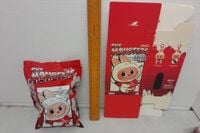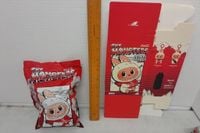On a seemingly ordinary afternoon in September 2025, a quiet upstate New York mall became the unlikely stage for a growing international crisis: the battle against counterfeit Labubu dolls. Steven Solimanto, a 75-year-old Lake George resident, was arrested at the Casual Girl store in Wilton Mall after attempting to sell over $1,000 worth of fake Labubu plush toys, according to Saratoga Today. Charged with second-degree trademark counterfeiting, Solimanto was released with an appearance ticket, but his arrest highlights a much larger, more troubling trend that’s swept across borders and continents.
Labubu dolls, the quirky, furry monster creations of Hong Kong-born, Dutch-raised designer Kasing Lung, have become a global sensation since their debut in 2015 and subsequent licensing to Chinese toy giant Pop Mart in 2019. Their appeal is undeniable—part European folklore, part pop culture phenomenon, and now, unfortunately, a prime target for counterfeiters. In 2025 alone, the official Labubu line has generated over $500 million for Pop Mart, as reported in their June earnings statement. But as the dolls’ popularity soars, so too does the shadow market of cheap, dangerous imitations.
This isn’t just a quirky crime story out of a small-town mall. The problem has reached epidemic proportions in the United Kingdom, where authorities have seized nearly 259,000 counterfeit toys at the border this year—an astonishing 90% of which were fake Labubu dolls, according to The Guardian and the UK’s Intellectual Property Office (IPO). The street value of these seized toys tops £3.5 million (about €4 million), with 236,000 of them being knock-off Labubus.
What’s driving this tidal wave of fakes? Demand, plain and simple. Labubu dolls aren’t just for kids. Thanks to viral social media trends and celebrity fans like Rihanna, the dolls have become must-have accessories for adults too, often clipped to handbags and backpacks. The result: a hidden market eager to cash in, flooding online and brick-and-mortar shops alike with imitations that, at first glance, seem like a bargain, but can come with a terrifying cost.
Authorities on both sides of the Atlantic are sounding the alarm. In August, the U.S. Consumer Product Safety Commission (CPSC) issued an urgent warning about counterfeit Labubu dolls, noting that the fakes are often small enough to fit in a child’s mouth, posing a serious choking hazard. "CPSC has also received reports of fake Labubu dolls that break apart easily, releasing small pieces that can become choking hazards," the agency stated. The warning was not just about the risk of choking; tests on seized dolls in the UK found many contained banned chemicals linked to cancer, as reported by ITV News and the Chartered Trading Standards Institute.
The scale of the safety problem is staggering. Three-quarters of the 259,000 fake toys intercepted in the UK this year failed critical safety tests, according to the IPO. These failures included the presence of toxic substances, parts that could easily detach and be swallowed, and even dangerous labeling. The IPO’s own research found that nearly half (46%) of people who bought counterfeit toys experienced serious issues, from toys breaking instantly to toxic odors and children falling ill. As the IPO’s deputy director of enforcement, Helen Barnham, put it: "With counterfeit toys, what you see is rarely what you get. Behind the packaging can be hidden choking hazards, toxic chemicals and faulty parts that put children in real danger. These products have bypassed every safety check the law requires, which is why we’re working with our partners to keep these dangerous fakes out of UK homes."
Despite these warnings, price remains a powerful lure. Surveys commissioned by the IPO reveal that while 92% of buyers are aware that counterfeit toys are sold in the UK, a whopping 70% say cost is their primary concern when making a purchase. Only 27% cite safety as a major factor. The IPO’s campaign, "Fake Toys, Real Harms," launched in 2025, aims to shift that balance—urging parents and gift-buyers to put child safety above a tempting deal.
For those trying to avoid being duped, experts offer some practical advice. Authentic Pop Mart Labubu dolls come with a holographic Pop Mart sticker, a scannable QR code linking to the official site, and—on newer editions—a subtle UV stamp on one foot. Real Labubu dolls sport nine pointy teeth, while fakes often get the count wrong or use overly bright colors. Buyers should also scrutinize packaging for spelling mistakes, check for UKCA or CE safety marks, and make sure there’s a legitimate UK or EU address on the box. And, as always, purchasing from trusted retailers or official brand websites is the safest bet.
But it’s not just about individual vigilance. Local authorities across the UK—from Edinburgh to Hull, Manchester to Hertfordshire, Nottingham to Coventry—have issued warnings about fake Labubu dolls, reflecting just how widespread the problem has become, according to NationalWorld. The IPO and its partners, including toy retailers and social media influencers, are working overtime to spread the word and keep dangerous fakes out of homes, especially as the holiday shopping season approaches.
For those who do spot a fake, the advice is clear: return it immediately, leave a review to warn others, and report it to Trading Standards. "Child safety must come first, so we’re urging parents – please don’t let your child be the tester," Barnham emphasized in an interview with NationalWorld.
Meanwhile, back in Wilton, New York, Solimanto’s arrest may seem like a small victory in a much larger war. Yet, it’s a stark reminder that the counterfeit toy crisis is no longer a distant, abstract problem—it’s here, it’s real, and it’s putting children everywhere at risk. As the holiday shopping rush draws near, the message from safety officials on both sides of the Atlantic is clear: look beyond the price tag, check before you buy, and don’t let a bargain put a child’s life in danger.
With the stakes as high as a child’s safety, the fight against fake Labubu dolls is one that demands vigilance, awareness, and, above all, a willingness to put well-being before a deal too good to be true.






